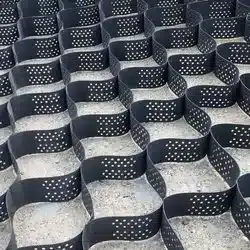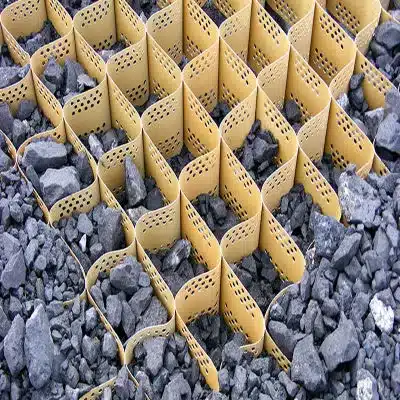+86-159 9860 6917
info@geofantex.com
geofantex@gmail.com
+86-400-8266163-44899
Geocell slope protection is an innovative method used to stabilize slopes and prevent erosion. Geocells are cellular confinement systems made from high-density polyethylene (HDPE) that provide a robust and flexible solution for a variety of civil engineering and environmental applications. This article explores the role of geocells in slope protection, detailing their functionality, maximum slope applicability, working mechanism, and the feasibility of filling them with concrete.
What is geocell in slope protection?
Geocell, in slope protection, is a three-dimensional, honeycomb-like structure made from durable materials such as HDPE. Employed to protect slopes from erosion and assist in stabilizing the surface, these cells are filled with soil, sand, gravel, or other materials to create a stable layer that holds the slope in place. The interconnected cells distribute loads evenly, reduce erosion, and improve the overall stability of the slope. Geocells are widely used in various construction projects, including road embankments, retaining walls, and slope stabilization, due to their effectiveness in preventing soil erosion and landslides.

What is the maximum slope for geocell?
The maximum slope for geocell installation can vary depending on the project requirements and specific geocell product used. Generally, geocells can effectively stabilize slopes up to a 45-degree angle. However, for steeper slopes, additional reinforcement techniques, such as anchoring systems or the use of higher-strength geocell materials, may be necessary to ensure stability and prevent erosion. Consulting with a geotechnical engineer is recommended to determine the appropriate solution for slopes exceeding the standard 45-degree limit.
How does Geocell work?
Geocell works by confining and reinforcing the infill material within its cellular structure. A three-dimensional cellular structure that can be filled with soil, gravel, or other materials to stabilize steep slopes and prevent erosion, geocells create a stable matrix when installed on a slope. This matrix distributes loads and minimizes lateral movement of the infill. This confinement increases the shear strength of the soil, reduces erosion, and provides a stable surface. The perforations in the geocell walls allow for drainage, preventing water buildup and further enhancing slope stability. By creating a unified and reinforced layer, geocells effectively prevent soil erosion and maintain the integrity of the slope.
Can you fill geocell with concrete?
Yes, geocells can be filled with concrete to create a more rigid and durable structure. In slope applications, geocell can be filled with angular rock, concrete, or with vegetated soil. Filling geocells with concrete is particularly useful in applications where higher load-bearing capacity and enhanced stability are required, such as in the construction of retaining walls, load support structures, and channel linings. The concrete-filled geocells provide a solid and stable surface that can withstand heavy loads and resist erosion. This combination of geocells and concrete offers a versatile solution for various civil engineering challenges, ensuring long-term durability and performance.
Geocell slope protection is a versatile and effective method for stabilizing slopes and preventing erosion. These three-dimensional cellular structures made from HDPE provide robust support by confining and reinforcing infill materials. Suitable for slopes up to 45 degrees, geocells distribute loads evenly and enhance soil stability. They work by creating a unified matrix that prevents lateral movement and erosion, and they can be filled with concrete for added strength and durability. Understanding the applications and benefits of geocell slope protection helps in selecting the right solution for various civil engineering and environmental projects.



Get Free Sample
We’ll respond as soon as possible(within 12 hours)





















